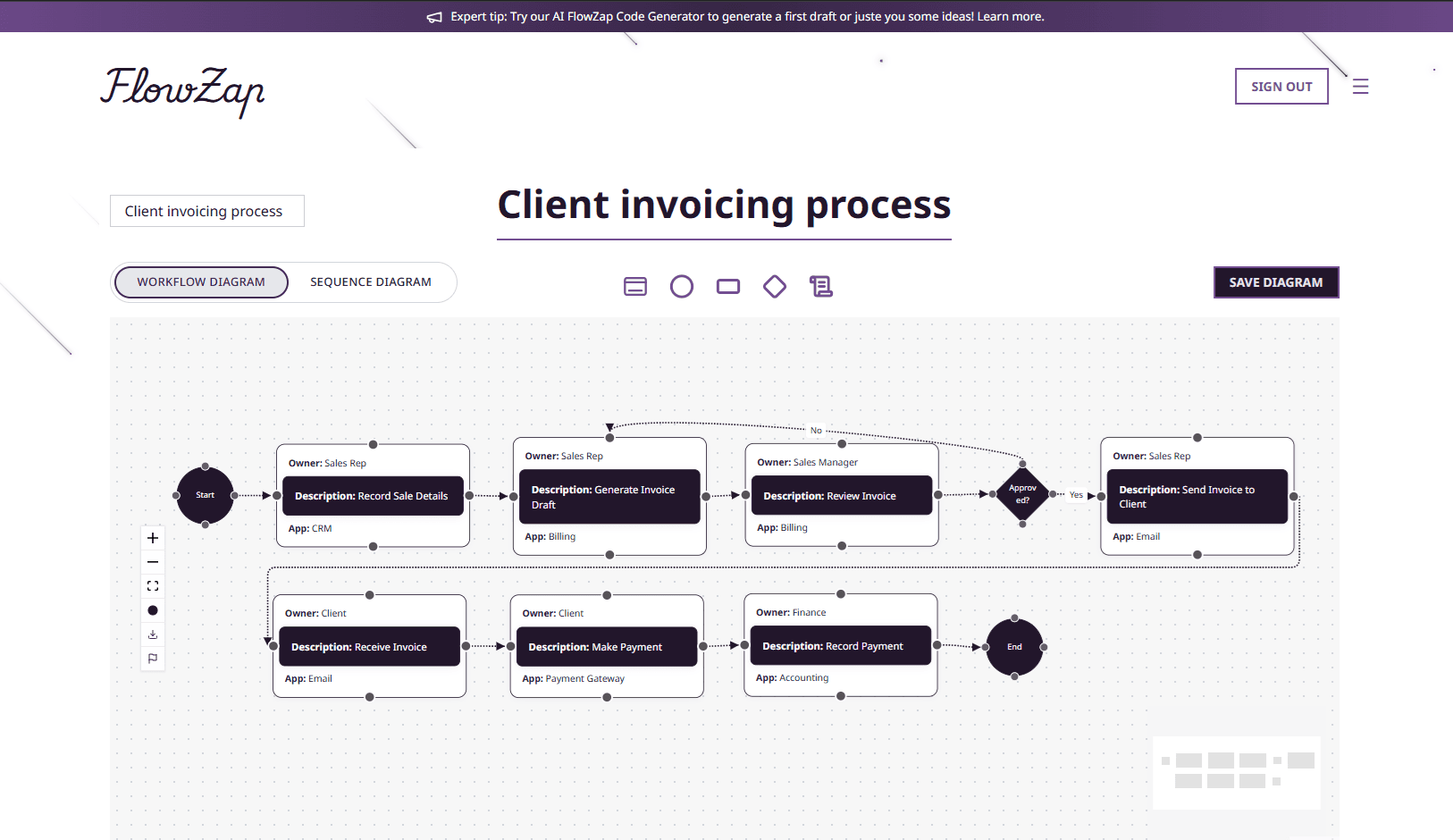I first came accross "Task Boxes diagrams" while completing a Shopify Certification. I think Shopify called those "Business Diagrams" but I found out at some point those diagrams don't rally have an official name. I loved those as they allowed me to conduct complicated workshops at a client with all sort of ressources. Task boxes diagrams provide a clear, visual method for mapping business processes using simple boxes to denote tasks, owners, descriptions, and systems, ideal for straightforward documentation without complex symbology. This format enhances process understanding by combining tabular data with sequential flow, making it accessible for teams in business analysis or software development.
Understanding Task Boxes Diagrams
Task boxes diagrams arrange business processes in a grid-like structure of connected boxes, each specifying an owner, task description, and system used. They differ from swimlane diagrams by avoiding dedicated lanes, opting for compact boxes that align sequentially to show progression. This setup directly answers key process queries: Who handles the task, what actions are involved, and which systems support execution.
Begin by outlining steps, then populate boxes with details like "Owner: Sales Rep; Description: Record Sale Details; System: CRM." Such diagrams form a core element in process management, expanding from high-level views to actionable steps. In tools like FlowZap, code generation renders these visuals from a single syntax, supporting view toggles for efficiency.
Benefits of Task Boxes Over Traditional Tables
A basic table listing Owner, Description, and System works for data entry, but task boxes transform it into a visual diagram for improved flow comprehension and team collaboration. Connections between boxes highlight dependencies and sequences, minimizing errors in interpretation during reviews. They offer a middle ground between plain lists and advanced BPMN charts, focusing on essentials without excessive notation.
Their ease of creation allows hand-sketching or digital rendering, scaling well for iterative updates in dynamic environments. By emphasizing common scenarios, task boxes streamline documentation, reserving details for annotations to maintain conciseness.
When to Choose Task Boxes Diagrams
Task boxes suit linear or mildly branched processes needing quick visualization, such as client onboarding or invoice handling, where detail clarity is paramount over intricate logic. They extend SIPOC overviews by breaking down process steps into owner-specific tasks, ideal for initial audits before full diagramming. In resource-limited settings, like small businesses or SOP development, they reduce barriers compared to formal standards.
Limit use to 5-15 tasks to prevent overcrowding; subdivide larger processes accordingly. They align well with agile practices for mapping user journeys or API workflows, supporting rapid iteration. Reserve more elaborate diagrams for conditional heavy processes, like multi-path approvals.
Ideal Scenarios
- Standard Operating Procedures (SOPs): Map routine actions, such as invoice generation and review, with assigned owners to avoid delays.
- Process Audits in Six Sigma: Detail steps post-SIPOC to spot inefficiencies in sales or finance flows.
- Team Transitions: Illustrate handoffs, from sales to finance in invoicing, for smoother operations.
- Development Prototyping: Outline workflow designs in tools like FlowZap for software teams.
Comparing to Other Process Visuals
Unlike swimlanes that separate roles via lanes, task boxes use integrated owner fields within boxes for compact, role-aware flows in simple sequences. Flowcharts incorporate decisions and arrows for branching, while task boxes embed descriptions in a tabular visual, better for overviews than complex routings.
Task boxes elaborate SIPOC's process column with task-level granularity, transitioning to BPMN for detailed modeling. For expansion, add links between boxes to evolve into comprehensive process maps.
Implementing Task Boxes in FlowZap
FlowZap facilitates task boxes through AI-driven code generation, where prompts specify the format to produce rendered diagrams. Users input natural language requests, and the tool outputs syntax that visualizes processes as boxed flows, viewable on the homepage example.
For instance, prompt the FlowZap AI with: "Use Task boxes to describe to me a typical client invoicing process." You must invoke "Task boxes" in your prompt. This yields code like the following, which diagrams the sales invoicing workflow from start to payment recording:
sales { # Sales
n1: circle label="Start"
n2: taskbox owner="Sales Rep" description="Record Sale Details" system="CRM"
n3: taskbox owner="Sales Rep" description="Generate Invoice Draft" system="Billing"
n4: taskbox owner="Sales Manager" description="Review Invoice" system="Billing"
n5: diamond label="Approved?"
n6: taskbox owner="Sales Rep" description="Send Invoice to Client" system="Email"
n7: taskbox owner="Client" description="Receive Invoice" system="Email"
n8: taskbox owner="Client" description="Make Payment" system="Payment Gateway"
n9: taskbox owner="Finance" description="Record Payment" system="Accounting"
n10: circle label="End"
n1.handle(right) -> n2.handle(left)
n2.handle(right) -> n3.handle(left)
n3.handle(right) -> n4.handle(left)
n4.handle(right) -> n5.handle(left)
n5.handle(right) -> n6.handle(left) [label="Yes"]
n5.handle(bottom) -> n3.handle(bottom) [label="No"]
n6.handle(right) -> n7.handle(left)
n7.handle(right) -> n8.handle(left)
n8.handle(right) -> n9.handle(left)
n9.handle(right) -> n10.handle(left)
loop [until approved] n3 n4 n5
}
This code captures essential steps: recording sales in CRM, drafting and reviewing in billing systems, sending via email, client payment through gateways, and finance recording in accounting—complete with approval loops for revisions. Edit the code to refine tasks, then regenerate the diagram for team review or export. For bilingual Montreal workflows, incorporate French descriptions to match local needs.
The homepage illustration shows a comparable team process: Analysts document in apps, leaders handle emails, members review designs—arranged in a readable left-to-right flow.
Conclusion
Task boxes diagrams simplify process mapping with their blend of structure and visuals, empowering analysts to document workflows efficiently via FlowZap. By leveraging targeted prompts and code, teams achieve precise, iterable representations that drive better collaboration and optimization in business operations.
Inspirations:
https://pressbooks.bccampus.ca/technicalwriting/chapter/figurestables/
https://www.cflowapps.com/business-process-diagram/
https://www.stampli.com/blog/invoice-processing/what-is-invoice-processing/
https://businessmap.io/blog/sipoc
https://ppcexpo.com/blog/table-vs-chart
https://www.heretto.com/blog/visuals-in-technical-documentation
https://www.processon.io/blog/business-process-diagram-tutorial
https://www.sweetprocess.com/business-process-mapping/
https://community.interfacing.com/docs/sop-1-map-business-processes/
https://gluu.biz/simple-process-mapping/
https://citoolkit.com/templates/sipoc-map-template/
https://tettra.com/article/business-process-document-types/
https://www.cincom.com/blog/cpq/billing-process/
https://stripe.com/resources/more/invoice-processing-101
https://www.freshbooks.com/hub/invoicing/how-to-invoice
https://www.softkraft.co/business-process-mapping/
https://www.blueprism.com/guides/business-process/diagram/
https://www.usemotion.com/blog/process-mapping-examples.html
https://www.blueink.com/blog/8-easy-steps-to-fill-out-an-invoice-correctly
https://www.freshbooks.com/hub/invoicing/processing-invoices
https://tipalti.com/resources/learn/invoice-processing/
https://www.arionerp.com/news/cost-optimization/overview-of-invoicing-management-system.html
https://start.docuware.com/process-incoming-invoices
https://docs.stripe.com/invoicing/overview
https://www.accelo.com/post/client-invoice-strategy-steps-tips
https://www.spendesk.com/blog/invoice-management/
https://www.irisglobal.com/blog/beginners-guide-to-billing-and-invoicing/
https://www.bill.com/learning/invoice-processing
https://www.hellobonsai.com/blog/invoicing-best-practices
https://www.sydle.com/blog/process-owner-5f5be6c3c053d93b8e3ba0ba
https://www.medius.com/glossary/what-is-invoice-processing/
